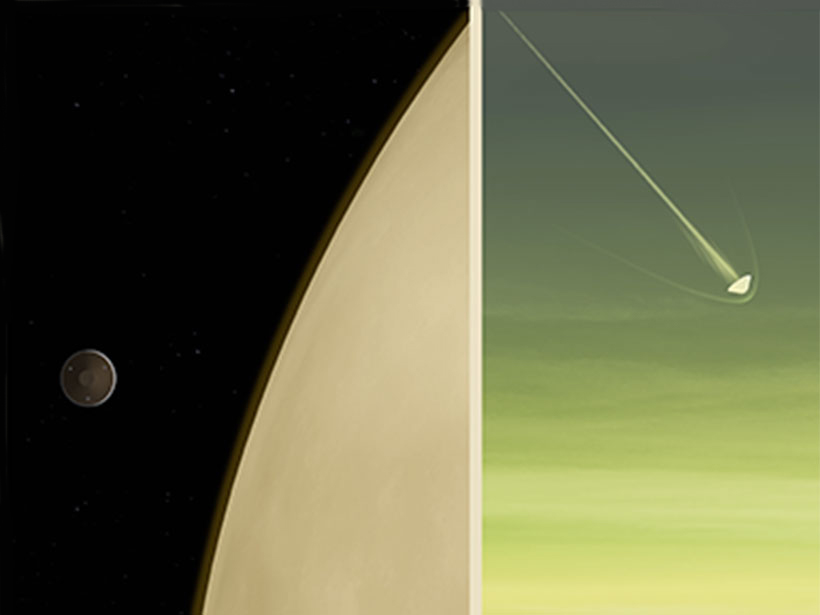A translation of this article was made possible by a partnership with Planeteando. Una traducción de este artículo fue posible gracias a una asociación con Planeteando.
Floating along Venus’s thick atmosphere are shadowy patches, morphing in shape and size, like huge algal blooms. Scientists first photographed these atmospheric features in 1927, and some researchers have suggested that these so-called unknown absorbers could be signs of life.
“Could there be life in the clouds?”
“For all we know [they] could be bacteria,” said Sanjay Limaye, a planetary scientist at the University of Wisconsin–Madison. “Could there be life in the clouds?”
Although scientists have their hypotheses, no one has confirmed what is causing the dark areas in the atmosphere. NASA’s new mission to Venus, DAVINCI+ (Deep Atmosphere Venus Investigation of Noble Gases, Chemistry, and Imaging), may bring scientists closer to an answer.
DAVINCI+ Answers the Call
The mission, announced in June, will drop a probe into Venus’s clouds—a beach ball–sized titanium sphere that will dive through the atmosphere and, for more than an hour, collect data while falling about 70 kilometers (43.5 miles). This mission, scheduled to launch between 2028 and 2030, will be the first time a spacecraft will probe the planet’s atmosphere in situ since 1985 when the Soviet Union’s Vega 2 investigated the planet’s atmosphere.
“We’re still trying to get the right measurements to simply ask the right questions.”
Set to launch around 2029, DAVINCI+ isn’t designed to detect life. “We’re still trying to get the right measurements to simply ask the right questions,” said Jim Garvin, DAVINCI+’s principal investigator. But among the mission’s other scientific goals, researchers hope it will help solve the mystery of these atmospheric patches and, more broadly, provide a deeper understanding of the atmosphere, which is crucial for determining Venus’s habitability.
An Old, Unanswered Question
Is there life on Venus? Because Venus has many similarities to Earth—such as its size and interior composition—many scientists once thought Venus could be an oasis for life. But when spacecraft began exploring Venus in the 1960s, they uncovered an inhospitable surface environment. The planet showcases a thick carbon dioxide atmosphere with crushing average pressures 92 times those at Earth’s sea level and surface temperatures hot enough to melt lead.
Then in 1967, Harold Morowitz and Carl Sagan proposed that although life can’t survive on the surface, some microbes may possibly survive in the clouds. Early Venus missions found evidence of water vapor in the atmosphere. In the cloud layers roughly 50 kilometers (30 miles) above the planet’s surface, atmospheric pressures are comparable to those at Earth’s sea level, and temperatures range between 100°C (212°F) and 60°C (140°F)—much cooler and more hospitable than the surface. On Earth, for instance, some organisms—such as microbes in hydrothermal vents—can survive in temperatures as high as 121°C (249.8°F).
In addition, the patches are created when something, perhaps microbes or some biological process, absorbs primarily ultraviolet light from the Sun amounting to about half the Sun’s energy that reaches Venus, according to Limaye. In 2018, Limaye and his colleagues found that the patches absorbed light at many of the same wavelengths as some terrestrial bacteria and biological molecules, such as proteins.
Using DAVINCI+ to Get One Step Closer
The unknown absorbers, of course, could be nonbiological. Scientists have already detected some sulfur-bearing compounds in Venus’s atmosphere that absorb at least some of the ultraviolet light, and other similar chemical species might be the main cause of the dark patches, Garvin said. DAVINCI+ will try to help determine the chemistry that’s producing the bulk of these dark patches and perhaps point scientists toward a biological or nonbiological origin.
During two flybys before it releases the probe, the DAVINCI+ carrier spacecraft will try to identify the absorbers using a high-resolution ultraviolet spectrometer. An ultraviolet camera will also take videos of the clouds at high resolution and study how the dark patches move.
If life does exist in the clouds, it likely would have originated the same way it did on Earth: in an ocean. Some computer models of Venus’s ancient climate suggest it did once have a shallow ocean, chemical traces of which might still exist in the planet’s atmosphere. An onboard mass spectrometer will measure hydrogen and its chemical sibling deuterium to reveal how much water the surface has lost throughout Venus’s history. The probe’s laser spectrometer will not only help identify what’s absorbing ultraviolet light but also measure chemicals important for determining habitability, such as sulfuric acid, water, and chemical nutrients.
“It is a great time to be interested in Venus….We’re going to learn spectacular stuff.”
Vastly superior to the instruments that last visited Venus decades ago, the spectrometers “are an order of magnitude higher in resolution [and] precision,” Garvin said.
DAVINCI+ won’t be alone at Venus. In the next decade, NASA, the European Space Agency, and the Indian Space Research Organisation will send three more spacecraft—VERITAS (Venus Emissivity, Radio Science, InSAR, Topography, and Spectroscopy), EnVision, and a to-be-named orbiter—to the planet, beginning a new era of Venus exploration. “It is a great time to be interested in Venus,” Garvin said. “We’re going to learn spectacular stuff.”
—Jaime Cordova (@jaimecor_94), Science Writer
Although referred to as DAVINCI+ in this article, the mission is in the process of changing its name, from DAVINCI+ to DAVINCI.
This piece was produced with support from the National Association of Science Writers’ David Perlman Virtual Mentoring Program.
Citation:
Cordova, J. (2021), Mission to Venus could help solve an atmospheric mystery, Eos, 102, https://doi.org/10.1029/2021EO163168. Published on 17 September 2021.
Text © 2021. The authors. CC BY-NC-ND 3.0
Except where otherwise noted, images are subject to copyright. Any reuse without express permission from the copyright owner is prohibited.

